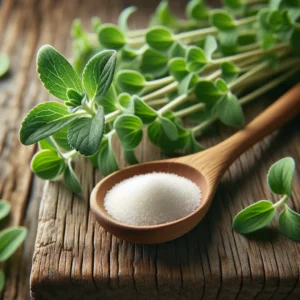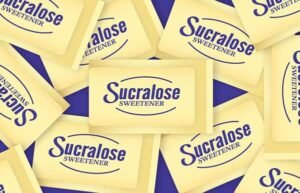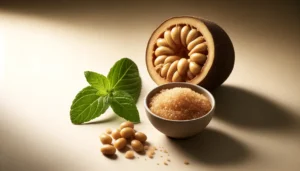Safe Sweeteners: Sugar Substitutes for Diabetics
When it comes to managing diabetes, selecting the right sweeteners is crucial for maintaining stable blood sugar levels. Traditional sweeteners like table sugar can significantly disrupt glycemic control, making the exploration of safer alternatives essential for those affected. Let’s dive into some of the best sugar substitutes for diabetics, offering detailed insights into their benefits and considerations.
Understanding the Impact of Sugar on Diabetics
For individuals living with diabetes, every food choice—especially those concerning sugar intake—plays a pivotal role in managing their condition. Consuming traditional sugars, such as sucrose (table sugar), can lead to rapid increases in blood glucose levels. These spikes are not just temporary fluctuations; they can contribute to long-term health complications, including heart disease, kidney disease, and nerve damage.
These blood sugar spikes are not just temporary fluctuations; they can contribute to long-term health complications, including heart disease, kidney disease, and nerve damage.
The Glycemic Challenge
Sugars are categorized by their glycemic index (GI), a system that ranks carbohydrates on a scale from 0 to 100 based on how quickly they raise blood glucose levels after eating. Foods with a high GI are absorbed quickly into the bloodstream, causing a rapid rise in blood sugar levels. For diabetics, ingesting high-GI foods can result in hyperglycemia—an excessively high blood sugar level—which can trigger acute symptoms and may require medical attention.
The Role of Insulin
In non-diabetic individuals, the hormone insulin helps to manage the influx of glucose into the blood by signaling the body to store excess glucose for energy. However, in diabetics, the body’s ability to produce or respond to insulin is impaired. This disruption leads to the inability to adequately regulate blood sugar levels, making the choice of low-GI sugar substitutes crucial for maintaining stability.
Long-Term Implications
Regular consumption of high-GI sugars can lead to worse glycemic control, which is linked to the progression of diabetes-related complications. Managing blood sugar levels through diet, including the choice of appropriate sweeteners, is essential for preventing the escalation of these conditions and promoting a healthier, more stable life.
Thus, the importance of selecting appropriate sugar substitutes for diabetics cannot be overstated. These alternatives provide the sweetness that individuals may desire without the associated risks of traditional sugar, helping to maintain better overall glycemic control.
Regular consumption of high-GI sugars can lead to worse glycemic control, which is linked to the progression of diabetes-related complications. The importance of selecting appropriate sugar substitutes for diabetics cannot be overstated.
Here’s a list of the best sugar substitutes for diabetics, their benefits and considerations
Stevia: The Natural Choice for Health-Conscious Sweetening
Stevia has emerged as a popular natural sugar substitute for diabetics that offers a potent alternative to sugar without the associated calories or glycemic impact. Derived from the leaves of the Stevia rebaudiana plant, a small perennial herb native to Paraguay and Brazil, stevia has been used for centuries by indigenous communities for its sweetening properties and medicinal benefits.

Composition and Extraction
The sweetness of stevia comes from its steviol glycosides, primarily stevioside and rebaudioside A, which are compounds extracted from the plant’s leaves. These glycosides are responsible for stevia’s incredible sweetness, which can be up to 300 times sweeter than table sugar. This high potency means that only a tiny amount is needed to achieve the desired sweetness, minimizing calorie intake without sacrificing taste.
Health Benefits
One of the most significant advantages of stevia is its negligible effect on blood glucose levels. This characteristic makes it an excellent choice for diabetics or anyone monitoring their blood sugar levels. Additionally, stevia does not contribute to tooth decay, which is a common problem associated with sugar consumption. Its use in food and beverages can help reduce overall caloric intake, supporting weight management and metabolic health.
Flavor Profile and Usage
While stevia is renowned for its sweetness, it also has a unique flavor profile that can include a slight bitterness or licorice-like aftertaste, particularly when used in high concentrations. Food scientists and manufacturers have worked to refine the extraction process to isolate the sweetest and least bitter glycosides, improving the taste of commercial stevia products. This ongoing development has expanded its use in a variety of products, from beverages to baked goods, making it a versatile ingredient in both home and commercial kitchens.
Regulatory Status and Safety
Stevia’s safety has been extensively evaluated by various global health authorities. It has been approved for use by major regulatory bodies, including the U.S. Food and Drug Administration (FDA) and the European Food Safety Authority (EFSA), which have classified high-purity steviol glycosides as safe for consumption. This endorsement has helped increase consumer confidence and adoption of stevia in daily diets.
Environmental Impact
Cultivating stevia also presents several environmental benefits. It is a hardy plant that requires less water and land compared to traditional sugar crops like sugarcane and beet. Furthermore, the sustainable farming practices associated with stevia cultivation contribute to biodiversity and soil conservation, making it a more environmentally friendly choice.
The Future of Stevia in the Sweetener Market
As demand for healthier and natural products continues to rise, stevia is well-positioned to play a significant role in the sweetener market. Its ability to provide intense sweetness without calories or negative effects on blood sugar levels makes it a valuable ingredient for creating healthier food and beverage options. Additionally, ongoing research and development into improving the taste and production efficiency of stevia are likely to enhance its appeal and accessibility even further.
In summary, stevia represents a compelling choice for anyone looking to reduce their sugar intake without compromising on taste. Its natural origin, health benefits, and environmental advantages make it a standout sweetener that aligns well with contemporary dietary trends and sustainability efforts.
Tagatose: A Fruit-Based Option
Tagatose is a lesser-known sweetener that deserves attention. Found naturally in some fruits, it is roughly 90% as sweet as sugar but has a much lower glycemic index. While it offers a healthier alternative, it is pricier and less available than other sweeteners.
Sucralose: A Versatile Sweetener for Baked Goods
Sucralose, a popular sugar substitute found in many low-calorie and diabetic-friendly products, offers several unique benefits that make it particularly effective for use in baking. Derived from sugar through a chemical process that replaces three hydrogen-oxygen groups on the sugar molecule with chlorine atoms, sucralose delivers a sweetness profile remarkably similar to that of sugar but without the associated calories or glycemic impact.

Maintains Sweetness Under Heat
One of the most significant advantages of sucralose is its stability when exposed to heat. Unlike some other artificial sweeteners, sucralose does not break down or lose its sweetness during the baking process. This stability makes it an ideal choice for a wide variety of baked goods, from cakes and cookies to bread and pastries. Whether the recipe involves baking at high temperatures or a prolonged cooking time, sucralose maintains its sweetness, ensuring the final product has the desired flavor profile.
No Excessive Sweetness or Aftertaste
Another critical aspect of sucralose is its ability to provide sweetness without overpowering the other flavors in the recipe. It is approximately 600 times sweeter than sugar, which means only a small amount is needed to achieve the same level of sweetness. This minimal use helps avoid the excessive sweetness that can sometimes occur with other sugar substitutes.
Moreover, sucralose is often praised for not having the bitter aftertaste associated with some other artificial sweeteners. While taste perception can vary from person to person, many consumers report that sucralose provides a clean, sugar-like taste without any unpleasant afternotes. This makes it a preferred choice for consumers who are sensitive to the aftertaste of sweeteners like stevia or aspartame.
Ideal for Reducing Calories in Baked Goods
For individuals monitoring their caloric intake, either for weight management or health reasons like diabetes, sucralose offers an effective way to enjoy sweet treats without the guilt. Since it is not metabolized by the body, it does not contribute any calories to the food in which it is used, making it a fantastic option for calorie-reduced baking.
Broad Compatibility
Sucralose’s lack of a significant aftertaste and its ability to blend seamlessly with other ingredients make it exceptionally versatile. It can be used in combination with other sweeteners, both natural and synthetic, to achieve a more complex sweetness profile or to mask any potential aftertastes from other ingredients. Its compatibility with a range of flavors and components allows it to be incorporated into nearly any recipe, enhancing the product’s taste without altering its intended flavor.
Sucralose is a highly adaptable sugar substitute for diabetics that works excellently in baked products. Its heat stability, appropriate sweetness level, absence of a significant aftertaste, and calorie-free nature make it a go-to choice for both home bakers and commercial food producers aiming to cater to health-conscious consumers without compromising on taste.
Aspartame: A Controversial Yet Common Choice
Aspartame, found in brands like Nutrasweet and Equal, is widely used for sweetening drinks but is not suitable for baking due to its instability at high temperatures. Moreover, it poses risks for individuals with phenylketonuria.
Acesulfame Potassium: An Emerging Substitute
Acesulfame potassium, or Ace-K, is emerging as a favored low-calorie sweetener. About 200 times sweeter than sugar, it is often combined with other sweeteners to enhance flavor.
Although considered safe by the FDA, ongoing research suggests a potential impact on weight gain, necessitating further investigation. We’ll be watching this one for further updates.
Saccharin: The Time-Tested Sweetener
Once mired in controversy, saccharin has been cleared of cancer concerns through extensive human studies. It offers a zero-calorie sweetness that is significantly stronger than sugar and is now regarded as safe for consumption.
Neotame: Potent and Efficient Sweetener for Diverse Dietary Needs
Neotame is a high-intensity artificial sweetener derived from the same family as aspartame, yet it boasts several advantages that make it distinct and highly beneficial for a variety of dietary applications, including for individuals with diabetes.
Exceptional Sweetness with Minimal Quantity
Neotame is recognized for its exceptional potency, being approximately 7,000 to 13,000 times sweeter than table sugar. This incredible intensity means that only a minuscule amount is required to achieve the desired level of sweetness, making it an efficient choice for food manufacturers and consumers alike. Its high sweetness level can significantly reduce the amount of sweetener needed in recipes, which can also lead to cost savings in large-scale production settings.
Stable Under High Temperatures
One of the key benefits of neotame is its remarkable stability when exposed to high temperatures. This characteristic makes it an ideal sweetener for baking and cooking, unlike some other artificial sweeteners that can break down and lose sweetness when heated. Neotame retains its sweetness properties during the baking process, ensuring that the final product maintains the desired flavor quality and intensity.
Suitable for a Wide Range of Diets
Neotame’s safety profile is well-established, with numerous studies affirming its safety for the general population, including those with diabetes. Its ability to provide sweetness without affecting blood sugar levels is particularly important for individuals managing their carbohydrate intake. Furthermore, since it is metabolically inert in humans—meaning it is not metabolized or stored in the body—it does not contribute calories or carbohydrates, making it an excellent choice for weight management and diabetic diets.
No Aftertaste
Another significant advantage of neotame is its clean taste profile. Unlike other sweeteners that may leave a lingering aftertaste, neotame is commonly reported to have a clean, sugar-like taste with no unpleasant residual flavors. This feature is particularly important in food products where maintaining the integrity of the original flavors is crucial.
Allergen-Free and Suitable for Phenylketonuria (PKU)
Neotame does not contain phenylalanine, a component present in aspartame that can be harmful to individuals with phenylketonuria (PKU), a genetic disorder that affects the metabolism of amino acids. This makes neotame a safe choice for people with PKU, broadening its appeal and usability across a wider audience who require strict dietary management.
Neotame’s potent sweetness, heat stability, compatibility with a variety of dietary needs, and clean taste profile make it a versatile and efficient sweetener choice in the culinary world. Its suitability for high-temperature cooking and baking, along with its non-caloric nature, ensures that it fits well into the diets of those looking to manage their sugar intake, including diabetics, without sacrificing taste or quality in their food.
Monk Fruit: The Exotic Natural Alternative
Monk fruit, also known as Luo Han Guo, is a natural sweetener that has gained popularity among those looking for healthier sugar alternatives, especially among diabetics. This sweetener is derived from a fruit native to Southeast Asia, which has been used for centuries in traditional Chinese medicine primarily for its healing properties. The extract from monk fruit offers a unique combination of health benefits and practical applications in cooking and baking.

Zero-Calorie Sweetness
Monk fruit sweetener is celebrated for its zero-calorie content, making it an excellent sugar substitute for diabetics, or for anyone monitoring their calorie intake. This attribute is particularly beneficial for diabetics who need to manage their weight and blood sugar levels carefully. Unlike many artificial sweeteners and sugar alcohols, monk fruit does not affect blood glucose levels, offering a safe way to enjoy sweetness without the risk of a spike.
High Intensity Natural Sweetener
The sweetness of monk fruit comes from natural compounds known as mogrosides, which are antioxidants that the fruit synthesizes during its growth. These compounds are incredibly sweet, approximately 250 times sweeter than table sugar. Because of its high sweetness intensity, only a small amount of monk fruit sweetener is required to achieve the desired taste, which helps avoid the use of excess sweeteners in recipes.
Health Benefits Beyond Sweetness
Monk fruit sweetener not only provides a no-calorie alternative to sugar but also delivers several health benefits. The mogrosides in monk fruit have been shown to possess anti-inflammatory properties, which can help in reducing inflammation in the body. This can be particularly beneficial for individuals with chronic conditions like diabetes, where inflammation plays a key role in the progression of the disease.
Versatility in Use
Monk fruit sweetener is versatile in its use and can be included in a variety of dietary plans. It is heat stable, making it suitable for both cold and hot dishes, from sweet beverages to baked goods. Its ability to withstand high cooking temperatures without breaking down or losing sweetness makes it an ideal ingredient in the kitchen for creating diabetic-friendly recipes.
Suitable for a Wide Audience
Monk fruit sweetener does not carry the aftertaste that some other natural sweeteners have, which can often be a significant drawback for those looking to replace sugar in their diet. Its clean, crisp sweetness closely mimics that of sugar, making it more palatable and easier to transition to for those accustomed to the taste of regular sugar.
Environmentally Friendly Cultivation
Monk fruit is grown in a specific region of Asia, and its cultivation has minimal environmental impact compared to the production of many artificial sweeteners and sugar crops. This sustainable aspect of monk fruit sweetening makes it an appealing choice for environmentally conscious consumers.
Monk fruit sweetener is a powerful, healthful sugar substitute that offers diabetes-friendly benefits, exceptional sweetness without the calories, and versatility in culinary applications. Its natural origin and array of health benefits make it a preferred choice for those seeking to reduce sugar intake while still enjoying the sweet flavors they love.
Allulose: The Underappreciated Natural Sweetener
Allulose, often overlooked in the sweetener market, is gaining recognition for its unique properties that distinguish it from other sugars and artificial sweeteners. Found naturally in small quantities in certain fruits, this rare sugar offers numerous benefits that make it particularly appealing for those looking to manage their diet without sacrificing the pleasures of sweet tastes.
Origin and Natural Occurrence
Allulose is a monosaccharide, or simple sugar, that is present naturally in several fruits including figs, raisins, and jackfruit. Its molecular composition is very similar to fructose, yet it behaves differently in the human body due to its unique enzymatic and absorption pathways. Because of its natural occurrence, it offers a sweetening option that is less processed compared to synthetic sweeteners, aligning with the growing consumer demand for clean and natural ingredients.
Health Benefits and Safety
The caloric value of allulose is remarkably low, providing roughly 0.4 calories per gram, which is about 10% of the calories found in standard sucrose. This reduced caloric impact makes allulose an excellent alternative for weight management. Additionally, allulose has a minimal effect on blood glucose and insulin levels, making it a safe choice for diabetics. It has been recognized by the U.S. Food and Drug Administration (FDA) as Generally Recognized as Safe (GRAS), affirming its safety for general consumption.
Impact on Blood Sugar Management
For individuals with diabetes, managing blood sugar is a constant challenge, and allulose offers a solution that can help control glycemic response after meals. Unlike sugars that are metabolized and contribute to blood glucose levels, allulose passes through the body without being fully absorbed, which means it does not significantly impact blood sugar or insulin levels. This property makes it particularly beneficial as a sugar substitute for diabetics, providing a way to enjoy sweet foods without the typical risks associated with sugar intake.
Culinary Versatility
Allulose is highly versatile in cooking and baking, closely mimicking the functional properties of sucrose. It dissolves well, making it easy to use in beverages and soft foods. In baking, it contributes to browning and moisture retention, similar to sugar, allowing it to be used as a one-to-one substitute in recipes. This ease of use extends the appeal of allulose to both home cooks and professional chefs, enabling the creation of lower-calorie versions of typically high-sugar foods without compromising texture or taste.
Environmental and Economic Aspects
The production of allulose is also environmentally conscious, with manufacturers often utilizing enzymatic conversion processes that reduce energy consumption and waste compared to traditional sugar production methods. Economically, as the demand and production scale increase, the cost of allulose is expected to become more competitive, making it a more accessible option for consumers seeking healthier dietary choices.
Allulose stands out in the sweetener market for its minimal caloric content, negligible impact on blood glucose, and its functional similarity to traditional sugar, making it an increasingly popular choice for those seeking healthier, sustainable, and diabetic-friendly sweetening options.
How Bakeries Can Better Serve Their Diabetic Customers
Commercial bakeries have a unique opportunity to cater to the diabetic community by incorporating sugar substitutes into their offerings.
A huge advantage with Keto PowerFlax products is that sugar substitutes work extremely well with all of our recipes. This is due to the high omega-3 content of the mix, which allows the sugar substite to dissolve and infuse into dough or batter much better than almond or coconut flour-based mixes.
In addition the high omega-3 content keeps the products from hardening or acquiring freezer burn in cold storage.
The Keto PowerFlax Baking Mix, which is not only keto-friendly but also plant-based, rich in fiber, protein, and omega-3 fatty acids, so bakeries can provide healthier, delicious alternatives to traditional baked goods. This not only helps in serving health-conscious customers but also expands the bakery’s market reach.

Selecting the right sugar substitutes for diabetics is essential for both individual health and commercial opportunities in the baking industry. By understanding the various options and their impacts, consumers and businesses can make informed decisions that benefit health without compromising on taste.
Keto PowerFlax not only helps you better serve your health-conscious customers but also expands your bakery’s market reach and increase sales and per-unit profits.
References:
- Additional information about high-intensity sweeteners permitted for use in food in the United States. (2018).
https://www.fda.gov/food/ingredientspackaginglabeling/foodadditivesingredients/ucm397725.htm - Bian, X., et al. (2017). The artificial sweetener acesulfame potassium affects the gut microbiome and body weight gain in CD-1 mice.
https://www.ncbi.nlm.nih.gov/pmc/articles/PMC5464538/ - Get to know carbs. (n.d.).
https://www.diabetes.org/healthy-living/recipes-nutrition/understanding-carbs/get-to-know-carbs - Guerrero-Wyss, M., et al. (2018). D-tagatose is a promising sweetener to control glycaemia: A new functional food.
https://www.hindawi.com/journals/bmri/2018/8718053/ - High-intensity sweeteners. (2017).
https://www.fda.gov/food/ingredientspackaginglabeling/foodadditivesingredients/ucm397716.htm - Saraiva, A., et al. (2022). Chemical analysis and nutritional profile, applications in the food industry and health impacts.
https://www.ncbi.nlm.nih.gov/pmc/articles/PMC9222424/ - Soffritti, M., et al. (2016). Sucralose administered in feed, beginning prenatally through lifespan, induces hematopoietic neoplasias in male swiss mice.
https://www.ncbi.nlm.nih.gov/pmc/articles/PMC4894270/ - Sollid, K. (2021). What is allulose?
https://foodinsight.org/what-is-allulose-a-different-kind-of-low-calorie-sweetener/ - Younes, M., et al. (2019). Safety of use of monk fruit extract as a food additive in different food categories.
https://www.ncbi.nlm.nih.gov/pmc/articles/PMC7008860/
The Next Step

- You can easily produce delicious keto-friendly products which are clean label, high protein and plant-based!
- Recipes provided on all bulk orders
- Worldwide shipping available
- Ongoing customer support always available
- To order, visit our wholesale distributor, SnowCap Enterprises, and search: Powerflax Gold Low Carb Mix (SNC80).
- Let’s talk – just fill out the form below!

